Good quality flashlights are plentiful in today’s market. Some are very inexpensive. However, not all cheap flashlights are a bargain. Some are just a waste of your money.
Today I review the ThruNite Archer 1A V3. This is a small flashlight that looks to be good for everyday carry (EDC.) Although compact, the light promises bright output and a variety of features for less than a pair of Andrew Jacksons.
While the light performed fairly well in testing, it is not without its quirks. Ultimately, it is a good flashlight for the money, though you should read the entire review to understand what you are buying.
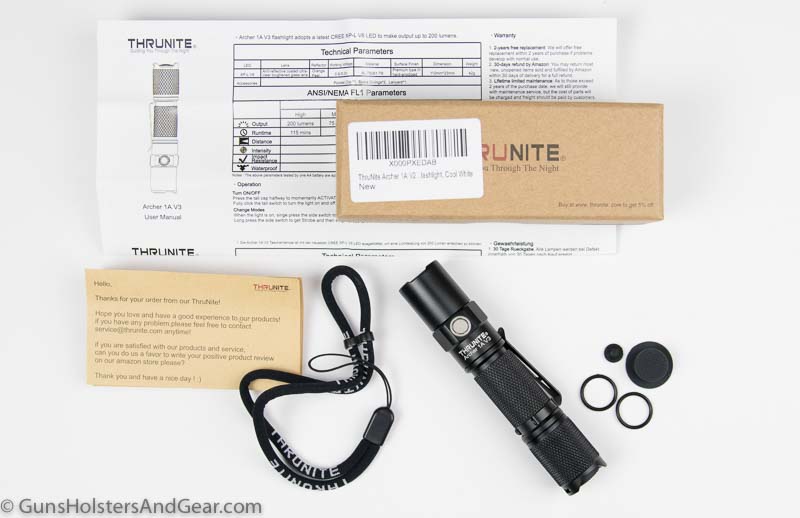
I’ve invested a lot of time into testing this light, and I hope the information is useful to you. If you have any suggestions, questions or comments, please leave them in the comments section.
Quick Takeaways
– affordably priced
– bright for its size
– passed drop & water resistance testing
– runtime did not measure up
– can be purchased here
Why Trust Me?
I’ve relied on flashlights for my safety for much of my life. For most of my law enforcement career, I worked nights and evenings. I depended on a flashlight daily to identify threats and handle a myriad of other activities in all kinds of weather.
Some flashlights failed at the worst possible times. Consequently, I became a self-taught flashlight aficionado simply to stay alive. Since then, I’ve developed into a bit of a flashlight nerd. I have been testing flashlights for years, and writing reviews of them for more than a decade.
I have interviewed numerous flashlight designers and have studied the ANSI/PLATO FL 1 (2016) standards. Additionally, I provide a full disclosure about any potential biases that may influence the review. I do not accept advertising or “sponsored” reviews.
General Information
The Archer 1A V3 is a small LED flashlight that operates on a single AA battery. It has a pair of buttons: one on the tailcap, and the second on the body near the head. The tailcap switch activates the light while the body switch rotates through the output settings.
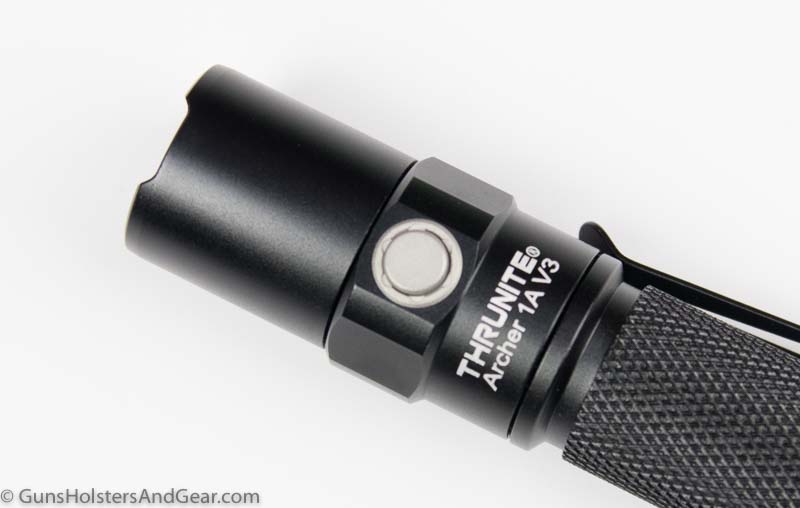
The light has five output settings. Four are varying intensities of constant operation. The final one is a strobe. Both the strobe and high output settings are rated at 200 lumens.
The body of the light is made of metal – possibly 6061 aluminum, though that is not specified by the company. The company claims the black finish is “premium type III hard anodized,” though the surface damage incurred during testing looks to be greater than that I’ve seen on a confirmed MIL-A-8625 finish aluminum product.
The flashlight has a suggested retail price of $35.95. It typically has a much lower price when purchased through Amazon.
The flashlight ships with a lanyard, spare button covers and spare O-rings. I’ve never needed to replace the O-rings on a flashlight, but it is a nice value-add to include them.
Output Levels
The following output levels were provided in the user manual provided with the flashlight.
| Lumens | Candelas | Beam Distance | |
| High | 200 | 1,088 | 66 meters |
| Medium | 75 | 1,088 | 66 meters |
| Low | 17 | 1,088 | 66 meters |
| Firefly | 0.1 | 1,088 | 66 meters |
| Strobe | 200 | 1,088 | 66 meters |
ThruNite listed the output levels in a chart that was part of the documentation included in the box. The chart is labeled “ANSI/NEMA FL 1 Parameters”. This is important as the FL 1 standard provides both a means for testing flashlights and regulations on how this information must be presented. At the time of this testing (March 2017), the most current FL 1 standard was revised in 2016.
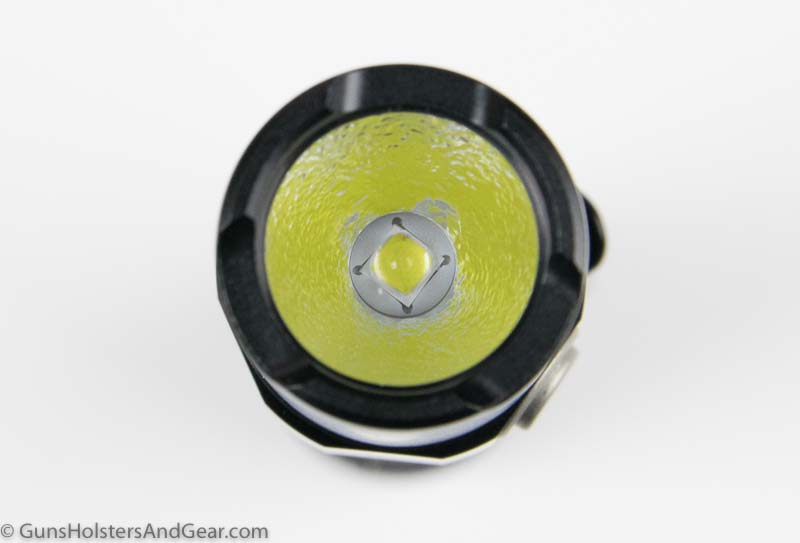
Right out of the gate, I doubted the veracity of at least some of the information. For example, ThruNite listed the peak beam intensity of all levels (including the 0.1 lumen “firefly” level) as 1,088 candelas. It also stated a beam distance of 66 meters for this level. Just on its face, this seems unbelievable.
Specifications
Here are the Archer 1A V3 specs:
| weight (w/o battery as stated by manufacturer) | 1.48 oz |
| weight (with alkaline battery as measured) | 2.5 oz |
| length | 4.3″ |
| body diameter | 0.8″ |
| head diameter | 0.8″ |
| impact resistance | 1 meter |
| water resistance | IPX8 (2 meters for 30 minutes) |
Testing
My review of a flashlight consists of two basic parts: formal testing and real-world use. The testing is of my own design and uses the FL 1 testing as an inspiration. My testing includes run time measurements, heat measurements, impact resistance and water resistance.
The object of this testing is to see how the light performs in a non-stressful environment. The testing is not scientific, but I do try to control for variables from test to test so that it is reasonable to compare one light I test against another I test.
My observations on real-world use are subjective and based on how the light handled daily activities. Obviously, there are many variables to daily use that are not controlled.
Output Over Time
As I’ve previously explained, my testing equipment is not suited for measuring the actual output (lumens) of the light. However, I believe it is accurate at measuring relative output. In other words, while I cannot tell you if the manufacturer’s lumens claim is accurate, I can reasonably determine if the runtime is in the ballpark.
Take a look at the following chart:
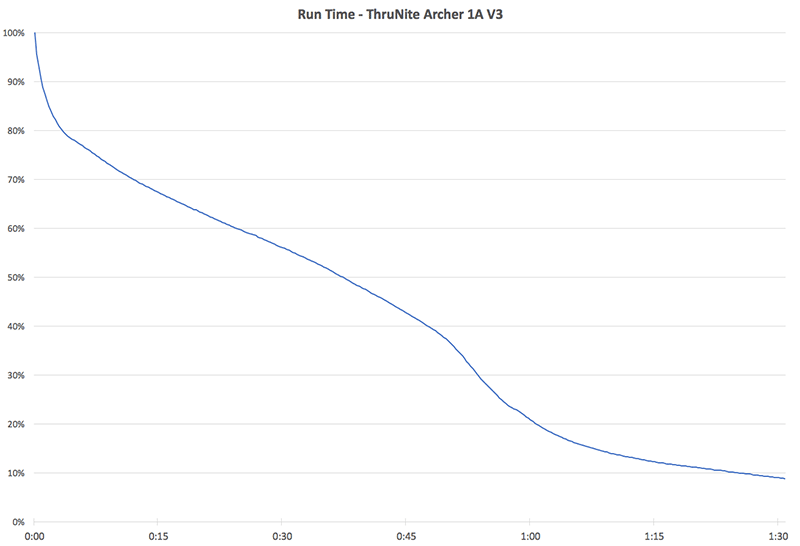
I recorded the output levels on the highest setting with a fresh Duracell alkaline battery. This is the same model battery I use for all alkaline AA battery flashlight tests. Testing was conducted indoors at room temperature – approximately 77Ëš F. More information on my testing can be found here.
As you can see, the output dropped sharply after being turned on. After about 5 minutes, the power drop moderated, but continued to decrease significantly.
According to the FL 1 standards, run time is measured from the initial output (30 seconds after being turned on) until output measures only 10% of its initial output. Using this run time standard, I measured a run time of 83 minutes. According to the company, the rated run time is 115 minutes. In my testing, I observed a 27.8% shorter run time than advertised.
This is significant. So, in an effort to give the company the benefit of the doubt, I ran the test again. This time I used another fresh Duracell alkaline battery from a different lot number.
The second run time chart is shown below:
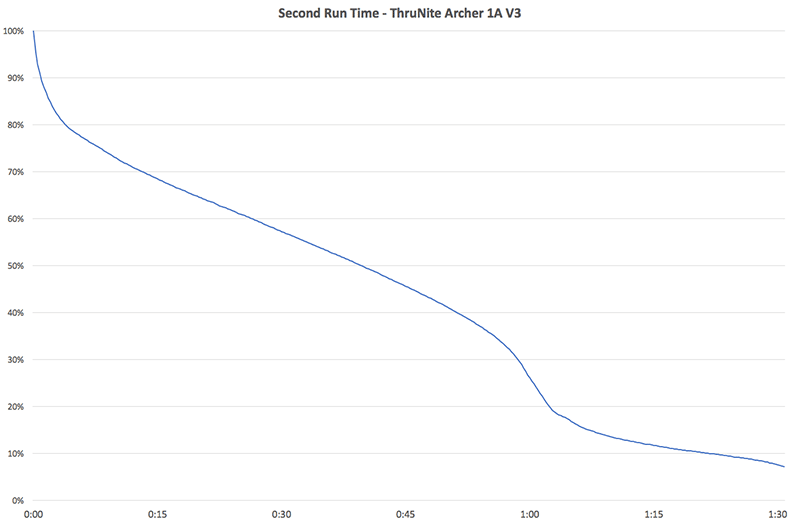
As you can see, the two output curves are similar. For the second run, the 90% drop was measured at 79 minutes – slightly shorter than the first run. This makes the measured second run 31.3% shorter than the stated number.
I could not find any information on what battery brand or model ThruNite used for its testing. Rather it states only that “[The FL 1 specifications listed] tested by one AA battery are approximate and may vary between lights, batteries and environment.” I should note that FL 1 (2016) 1.3.1 states that the sample size for run time (battery life) is three.
Additionally, according to FL 1 (2016) 2.4.2:
If the product is sold without batteries and a Run Time claim is made, the specific battery type and chemistry used for performance testing shall be stated visibly on the outside of the package.
Unfortunately, I could find no battery information on the outside of the ThruNite package.
Update: Through e-mail, a ThruNite company representative stated that company engineers used a Panasonic battery with a 2,450 mAh capacity to test the light. Although the company was not able to specify any further, I believe the battery in question may be the Panasonic Eneloop Pro 2,550 mAh NiMH. Those batteries have a specified minimum storage of 2,450 mAh.
I did not have any Eneloop Pro batteries on hand. However, I did have some Tenergy 2,600 mAh NiMH batteries. Although not identical to the Panasonic batteries, I believe the Tenergy would at least be indicative of what you might expect with the Eneloop Pro. That is, of course, assuming the Eneloop Pro is what ThruNite used for testing.
This chart is what I measured with the Tenergy AA battery:
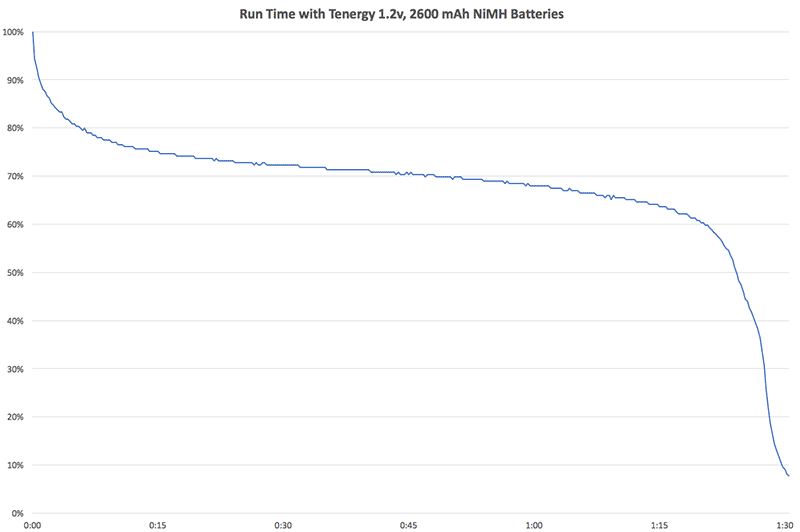
With the Tenergy battery, overall runtime to 10% was slightly better than with the Duracell alkaline batteries: 90 minutes. Although better than my prior testing, it was still significantly shorter than the company’s stated runtime of 115 minutes.
Hopefully, the company will update its packaging to better inform consumers of the battery type used for testing.
Realistic Run Time
The FL 1 standard calculates a run time measurement from full power to just 10% of the initial output. In my view, this is a poor performance indicator for two reasons. First, the time can be gamed by a company offering a high output number (lumens) that drops down after two minutes to 15% of the output level. Then the light could sip on the battery for hours to get a ridiculously long run time.
Second, few people will ever run a set of batteries to 10%, as that light level tends to not be useful – especially for a self-defense tool. I believe most people will replace the batteries in a flashlight when they notice an appreciable drop in output. I estimate that to be at about the 50% mark. I consider this to be a more realistic run time.
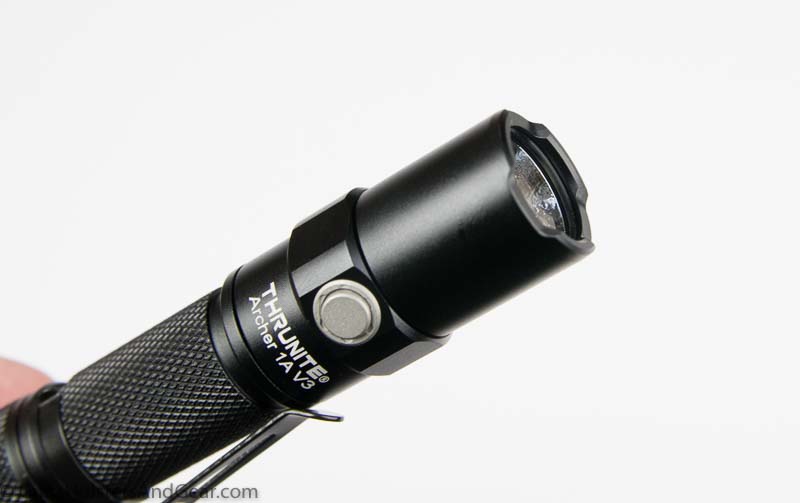
To get an idea of what 50% and 10% output looks like with the ThruNite flashlight, scroll down to the next section called “Visual Comparison.”
The 50% run time on the ThruNite Archer 1A V3 is less than 40 minutes based on my testing. On the first test, I measured a 50% run time as 36 minutes. On the second test, I measured 39 minutes.
On the whole, a 35+ minute 50% run time isn’t terrible based on other 1 AA flashlights I have tested. For example, the Nightstick MT-210 had a 50% run time of only 6 minutes! However, other lights do much better. For example, I measured 77 minutes to the 50% mark with the Streamlight ProTac 1AA flashlight.
Update: As stated in the section above, I ran the runtime test a third time. This test was using a Tenergy 2,600 mAh NiMH battery. This battery significantly improved the runtime to 50%. With the Tenergy battery, the Archer flashlight continued to offer at least 50% of its initial output through 84 minutes. That’s actually pretty good. It also shows how quickly the light output falls after that point. For comparison’s sake, keep in mind that the Streamlight mentioned above hit 77 minutes with a standard alkaline battery.
Visual Comparison
Charts and stats may not mean much to the average person, but pictures can truly tell a story when it comes to flashlights. The following photos are meant to help you visualize the differences of light output.
This pair of photos show the ambient light and with the flashlight on high output mode with a fresh battery. Drag the slider left and right to reveal more of each photo.


This pair of photos shows the Archer 1A V3 with light output with a fresh battery (left side) and after running for 36 minutes (roughly 50% output.)


The below photo shows the ThruNite flashlight with the full light output with a fresh battery (left side) and after running for about 83 minutes (roughly 10% output.)


Finally, the below photos compare the ThruNite Archer flashlight (left side) with the Streamlight ProTac 1AA (right side). The ProTac 1AA is an older LED flashlight that also operates on 1 AA battery. It is only rated for 70 lumens – about a third of the ThruNite. Both had a fresh Duracell battery for the photos.


Note: All of the above photos were taken at night with a Canon 80D camera in manual mode (f8.0, 0.5 seconds, ISO 400) at the same focal length and with the focus locked. Photos were taken hours before moonrise, so there was virtually no ambient light. The distance between the light and the target is 25 feet.
Heat Generation
All flashlights, even those with an LED, generate heat. Some of the high-output lights get exceptionally hot: 140° F or more. Fortunately, that is not the case with the ThruNite Archer 1A V3 battery. Its modest light output is reflected in its low heat generation.
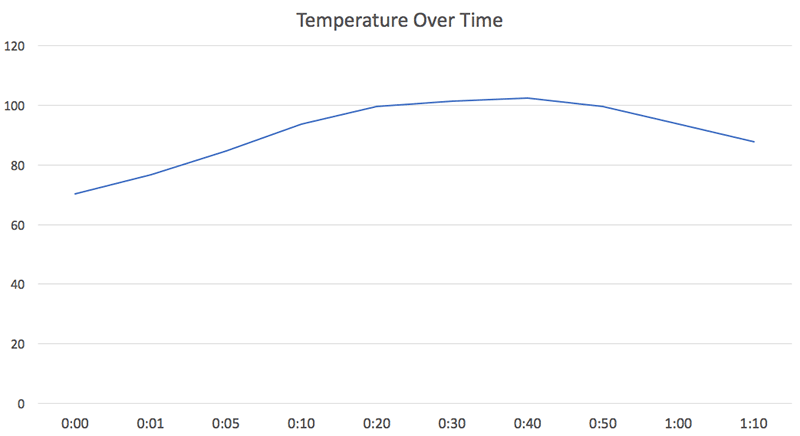
As you can see in the above graph, the surface heat of the flashlight peaks at a little over 100° F. Since the heat is concentrated at the head only, and you have to run the light continuously for about 20 minutes to break the century mark, it is unlikely the heat will ever bother you.
Drop Test
To evaluate impact resistance, I developed a test that is similar to that used by the FL 1 standard. For my test, I dropped the Archer flashlight onto hard concrete six times from a height of 1 meter. This height is the impact resistance rating provided by the company.
If you think of the flashlight as a cube, I dropped it one time on each of those six sides. I have pre-measured lengths of PVC tube that I use for my tests so I know that, from flashlight to flashlight, my drop height will be consistent.
After six drops, the ThruNite flashlight continued to work. I could not find any cracks in the body or lens. Based on my experience, the drop test is where most flashlights fail, so the ThruNite did what a lot of other lights cannot.
Damage to the finish will never fail a light in the drop test. However, it can be suggestive in determining how durable the finish may be long term.
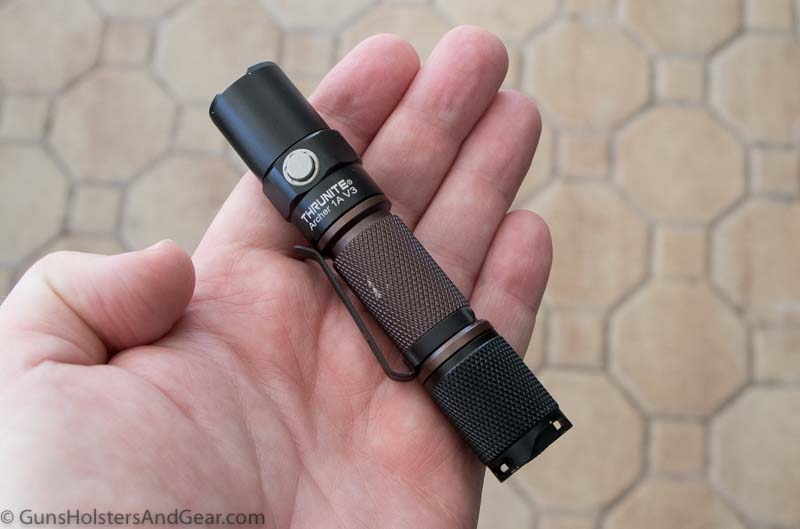
The ThruNite scuffed easily on the concrete. This is not surprising as all lights do show some signs of surface damage. However, the damage was more obvious than on some other flashlights. The finish, while durable for average use, did not seem to be as tough as the Type III hard coat anodizing I’ve seen on other aluminum products.
Water Resistance
ThruNite rates the Archer 1A V3 flashlight as IPX8 for water resistance. This means the flashlight is submersible for a period of no less than 30 minutes at a depth specified by the manufacturer. In this case, 30 minutes at 2 meters.
I test lights in my pool. Unfortunately, it is not 2 meters deep. Rather it is closer to 1.6 meters. So, for this test, I dropped the light in and kept it at that depth for 2 hours. The pool temperature was approximately 63° F.
After 2 hours, the light continued to work and showed no signs of water intrusion. While it was not a 2-meter test, I am comfortable with the ability of this light to keep water out of the important bits.
Real World Use
Ok, I’ve given you the numbers on this light. Now, let’s talk about how it performed in day-to-day activities. For much of the test period, I carried this in my support side front pocket with a Glock 43 on my strong hip. I also worked with this light and a Glock 19.
Overall, my impression was positive. The light worked every time I hit the switch, it carried well in a pocket and I found the beam was good for room sized illumination.
As I mentioned earlier in the article, the light has two switches: one in the tail cap and the other on the body. To turn the light on, you click the tail cap switch in for a constant beam. A partial press gives you a momentary activation.
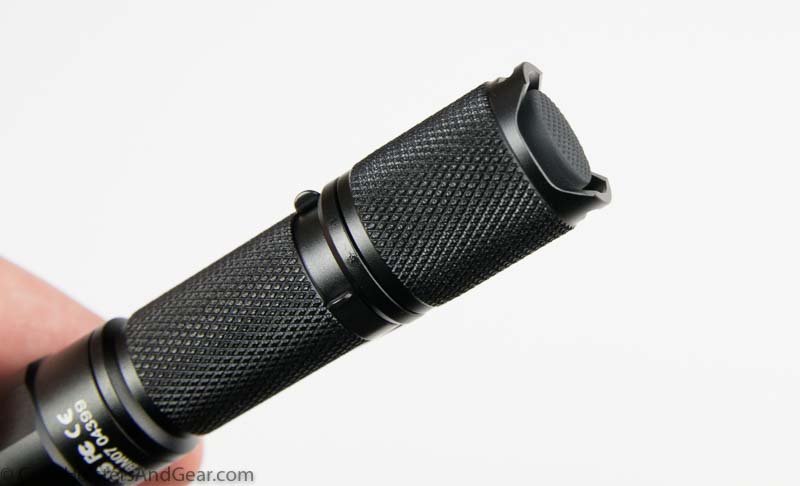
The tail switch is protected by a pair of “ears” that extend from the body and prevent accidental activation. During my time with the light, I had no accidental activations. Getting a momentary activation was relatively easy, but was still a very intentional act. Clicking it in for the constant mode is a deliberate action. I cannot conceive of any reasonable way this would be accidentally done.
For output mode selection, you use the body switch. This switch is smaller than the tail switch, and while it is not protected, I did not accidentally engage it at any point.
By pressing on the body switch, the flashlight rotates through each mode starting at the firefly and stepping up through low, medium and high. A word of caution: the light will not default back to the high output mode. So, if you turn it off in firefly mode, it will turn back on in firefly mode the next time you need the light.
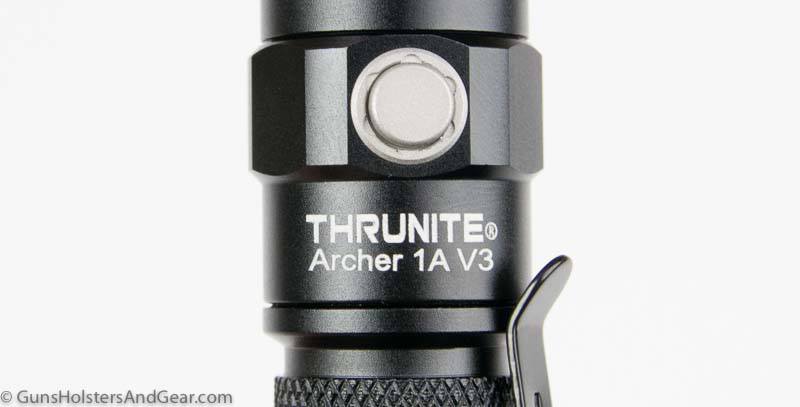
To access the strobe mode, you press and hold the body switch for about 1.5 seconds. To exit the strobe mode, click either of the switches. The light will not turn on in strobe mode even if you turn it off in strobe mode.
I found that I went through more batteries than I have with other 1AA flashlights I have used.
With a fresh battery, I found that the light was good for illuminating large rooms in my home. For many of the typical flashlight techniques you might use in home defense, the light performed well enough.
The beam appears to be fairly wide, and the ThruNite Archer was not particularly good at illuminating objects at farther distances. Across a typical, small suburban yard, the light would help you identify a person but not what was in his or her hand.
Final Thoughts
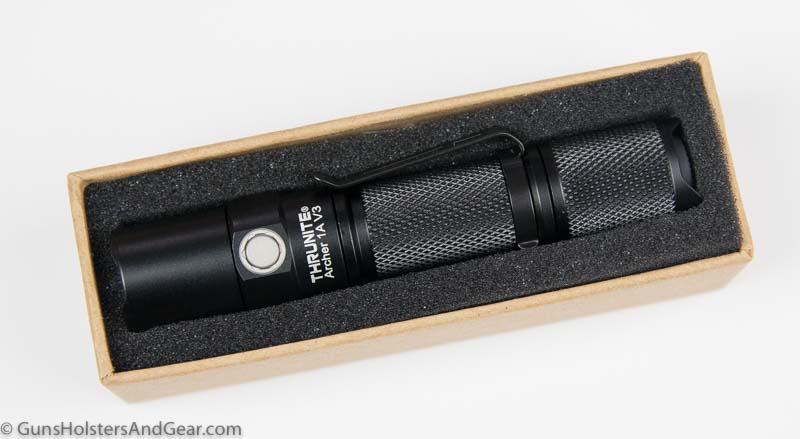
The ThruNite Archer 1A V3 is a solid performing flashlight at a reasonable price. For every day carry (EDC) on a budget, it isn’t a bad choice. But, it is not my first choice.
Based on my testing, I would take the manufacturer’s stated specifications with a grain of salt when comparing it to other lights. However, it did perform well in drop testing and water resistance testing.
For the money, the Archer is a decent flashlight option. For about $10 more, you can get the Streamlight ProTac 1AA that has a much better real world run time. However, Streamlight recently introduced the ProTac 1L-1AA dual fuel light that offers both better output and runtime for only about $15 more than the ThruNite. I plan on testing the ProTac 1L-1AA in the near future.
Last Update: August 5, 2021
Disclosure
You deserve to know all of the potential biases that may influence this review. To help you, I established a policy of full disclosure on every one of the reviews at GunsHolstersAndGear.com.
- This flashlight was provided to me by ThruNite. A company representative contacted me and requested I do a review of this light. To that end, they shipped me the light used in this review. I was not charged for the light.
- No promises were offered by me or solicited by ThruNite for a positive review.
- No money or other consideration was offered by ThruNite or solicited by me to conduct this review.
- ThruNite is not an advertiser, nor are we in any discussions for them to be one. In fact, at this time, I do not accept any advertising on GunsHolstersAndGear.com.
- I do not have any financial interest in any flashlight or outdoor company.
GunsHolstersAndGear.com is a for-profit website. I do not charge readers a dime to access the information I provide.
Some of the links on this page and site are affiliate links to companies like Amazon and Palmetto State Armory. These links take you to the products mentioned in the article. Should you decide to purchase something from one of those companies, I make a small commission.
The links do not change your purchase price. I do not get to see what any individual purchases.
Unlike years past, manufacturers are now throwing a lot of money at online publishers. Many so-called reviews are actually sponsored by the manufacturer. This means the article was paid for. Do you really think you are getting an honest review from that site?
I encourage you to post your own experiences with the ThruNite Archer 1A V3 flashlight in the comments section below. Additionally, if you have any questions about the light or my review policy, please ask below.
TL;DR
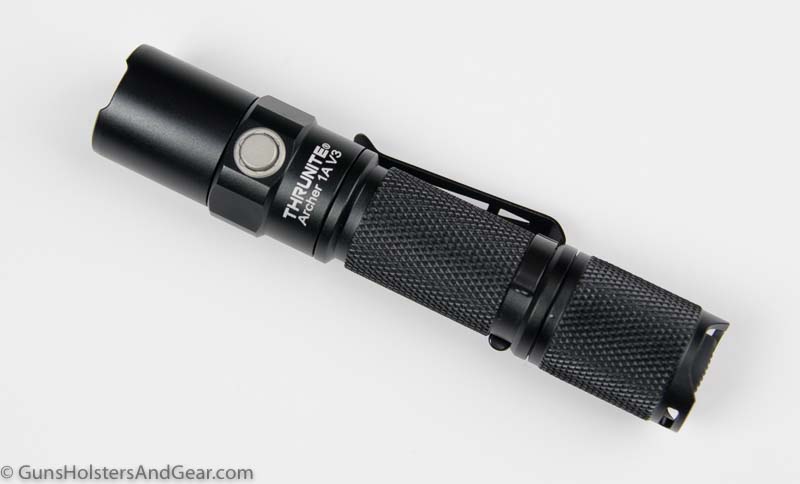
For the money, the ThruNite Archer 1A V3 flashlight is a good EDC torch. My testing showed a shorter run time on high than the company markets. However, the light passed drop testing, water resistance testing and performed well in every day use. For a little more money, one can buy the Streamlight ProTac 1L-1AA light that offers more lumens and a longer run time.
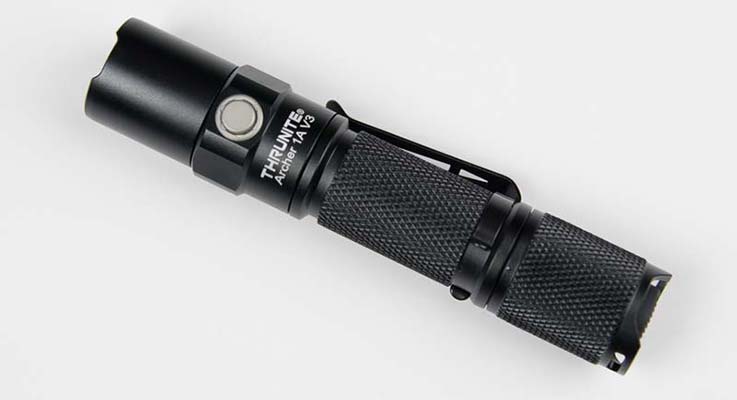
2 replies on “ThruNite Archer 1A V3 Review”
Sounds like a decent light, but for the money, I’d rather keep the Coast HP1 I have now. The HP1 is less than $10 on Amazon.
Thanks for taking the time to post. As it so happens, I just picked up an HP1 for review. Sounds like you like yours.
-Richard